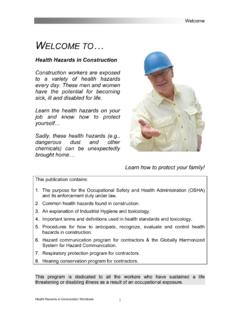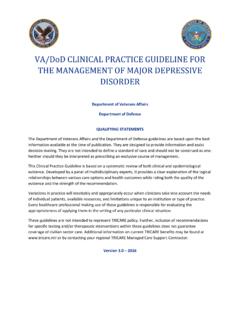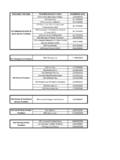Transcription of Basic Principles in Occupational Hygiene
1 STUDENT MANUAL. Basic Principles in Occupational Hygiene July 2019. This course is offered by the Occupational Hygiene Training Association and available free of charge though the OHTA website Copyright information This student manual is provided under the Creative Commons Attribution - NoDerivs licence agreement. It can only be reproduced in its entirety without change, unless with the prior written permission of OHTA. Occupational Hygiene Training Association, 5/6 Melbourne Business Court Millennium Way, Pride Park, Derby, DE24 8LZ. Email: TABLE OF CONTENTS. ACKNOWLEDGEMENTS i 1 INTRODUCTION 1. HISTORY 3.
2 THE IMPORTANCE OF Occupational Hygiene 6. 2 HUMAN PHYSIOLOGY AND INDUSTRIAL DISEASES 8. SKIN 8. Dermatitis 9. Physical damage 10. Biological agents 10. Cancer 11. Other effects 11. MUSCULOSKELETAL SYSTEM 11. NERVOUS SYSTEM 12. ENDOCRINE SYSTEM 14. THE CIRCULATORY SYSTEM 15. The blood 17. RESPIRATORY SYSTEM 18. THE GASTROINTESTINAL TRACT 21. THE LIVER 22. URINARY SYSTEM 23. THE EYE 23. 3 FUNDAMENTALS OF TOXICOLOGY 25. INTRODUCTION 25. TERMS 25. Basic CONCEPTS 26. Physical form 27. Dose 27. Route of entry / absorption 28. Metabolism 29. Excretion 29. Response to toxins 30. STAGES OF TOXICOLOGICAL EVALUATION 30.
3 What adverse effects can a chemical cause? 30. Are the effects seen in animals relevant to man? 31. SAFETY DATA SHEETS 31. 4 EXAMPLES OF HAZARDOUS SUBSTANCES / PROCESSES 33. CRYSTALLINE SILICA 33. MACHINE MADE MINERAL FIBRE (MMMF) 34. WELDING FUME 35. ISOCYANATES 36. WOOD DUST 36. PHARMACEUTICALS 36. PETROLEUM PRODUCTS 37. MINING MINERAL AND METAL EXTRACTION 39. METAL USE AND REFINING 39. DIESEL EXHAUST 40. NANOPARTICLES 42. 5 ASSESSMENT OF HEALTH RISKS 43. INTRODUCTION 43. HAZARD AND RISK 43. ASSESSMENT OF HEALTH RISKS 43. Define the extent of the assessment 44. Gather information 44. Assess the health risk(s) 45.
4 Specify any action required 46. Record the risk assessment 47. Carry out the actions 47. Review the risk assessment 47. Communication / consultation 48. EXPERT SYSTEMS AND CONTROL BANDING 48. 6 MEASUREMENT OF AIRBORNE CONTAMINANTS 49. GENERAL Principles 49. Sampling techniques 50. Types of sampling 50. SAMPLING EQUIPMENT 53. SAMPLING RECORDS 54. SAMPLING FOR AIRBORNE PARTICULATES 54. Particle size 54. Elements of a sampling system 55. SAMPLING FOR GASES AND VAPOURS 57. Sampling equipment 57. Sampling methods 61. Fixed position sampling 62. SAMPLING STRATEGIES 63. Identification of airborne contaminants 63.
5 Leakages and spillages 63. Assessment of the effectiveness of control measures 63. METHODS OF ANALYSIS 63. Organic vapours 64. Inorganic gases 64. Organic particulate matter 64. Metals and their compounds 64. Mineral dusts 64. Diesel particulate matter (measured as elemental carbon) 65. CALIBRATION AND QUALITY CONTROL 65. 7 Hygiene STANDARDS AND Occupational EXPOSURE LIMITS 66. INTRODUCTION 66. SETTING OF Hygiene STANDARDS AND EXPOSURE LIMITS 66. Hygiene STANDARDS FOR CHEMICAL AGENTS 67. Quantifying airborne concentrations of chemical agents 68. Categories of exposure limits 68. "Skin" notation 69.
6 Effects of mixed exposures 69. Calculation of exposure with regard to the specified reference periods 70. BIOLOGICAL MONITORING GUIDANCE VALUES 72. 8 BIOLOGICAL MONITORING AND HEALTH SURVEILLANCE 73. URINE 75. BLOOD 76. SKIN 76. BREATH 76. X-RAYS 77. NEUROLOGICAL TESTS 77. AUDIOMETRY 77. LUNG FUNCTION TESTS 77. Lung volume and forced expiratory volume (FEV1) 77. Airways resistance 77. 9 GENERAL APPROACHES TO THE CONTROL OF RISKS TO HEALTH 79. TYPES OF CONTROL MEASURES 79. Elimination / substitution 80. Isolation 80. Segregation 80. Engineering controls 81. Administrative controls 82. Information, instruction and training 83.
7 Personal protective equipment (PPE) 84. 10 VENTILATION 85. TYPES OF CONTROL 85. GENERAL FEATURES OF AN LEV SYSTEM 85. General considerations 86. Inlets / hoods 87. Ductwork 91. Air cleaners 92. Air movers 93. Discharge to atmosphere 93. MAINTENANCE, EXAMINATION AND TESTING OF VENTILATION SYSTEMS 94. Legal requirements 94. Regular maintenance 94. Thorough examination and testing 95. 11 ASBESTOS 96. BACKGROUND 96. Types of asbestos 96. Properties of asbestos 97. Uses of asbestos 98. Airborne asbestos fibres 99. Exposure to asbestos fibres 99. HEALTH HAZARDS OF ASBESTOS 99. ASBESTOS REGISTER 100. Function of the asbestos register 100.
8 REMEDIAL TREATMENT OF ASBESTOS CONTAINING MATERIALS 101. Asbestos removal 101. Asbestos repair / encapsulation 101. Asbestos management programme 102. 12 BIOLOGICAL HAZARDS 103. INTRODUCTION TO BIOLOGICAL HAZARDS 103. LEGIONELLA AND HUMIDIFIER FEVER 105. Legionella 105. Humidifier fever 107. BLOOD BORNE DISEASES 107. Hepatitis B 108. Hepatitis C 109. HIV - (Human Immuno-deficiency Virus) 110. ZOONOSES 110. Anthrax (ACDP Group 3) 111. Leptospirosis (Hazard group 2) 112. Salmonellosis 112. Q Fever 112. MOULDS 113. PANDEMICS 113. GENETIC MODIFICATION 114. 13 NOISE 116. BACKGROUND 116. THE EAR 116. AUDIBLE SOUND 117.
9 HEALTH EFFECTS OF EXCESSIVE NOISE 118. ADDITION OF SOUND LEVELS 120. FREQUENCY ANALYSIS 120. DECIBEL WEIGHTINGS 121. EQUIVALENT CONTINUOUS SOUND LEVEL (LEQ) 122. NOISE DOSE 122. Calculating Lep,d 123. NOISE LIMITS 123. Other limits 124. HEARING CONSERVATION 124. Assessment of workplace noise 124. Control of workplace noise 126. Protection of personnel at risk 126. Information instruction and training 127. 14 VIBRATION 128. INTRODUCTION 128. Frequency 129. Amplitude 129. Acceleration (measure of vibration intensity) 129. EXPOSURE TO VIBRATION 129. HEALTH EFFECTS OF VIBRATION 130. MEASUREMENT OF VIBRATION 131.
10 15 THERMAL ENVIRONMENT: Principles , EVALUATION AND CONTROL 132. HUMAN RESPONSE TO THE THERMAL ENVIRONMENT 132. Physiological responses to heat 132. Physiological responses to cold 133. Psychological responses to the thermal environment 133. HEAT TRANSFER FROM THE BODY 133. EVALUATING THE THERMAL ENVIRONMENT 134. Metabolic rate 134. Personal insulation 135. Duration of exposure 136. Dry bulb temperature 136. Globe temperature 137. Mean radiant temperature 137. Air velocity 138. Moisture content 138. Personal monitoring 139. HEAT STRESS INDICES 140. THERMAL COMFORT 141. COLD STRESS 142. CONTROLLING THE THERMAL ENVIRONMENT 142.




